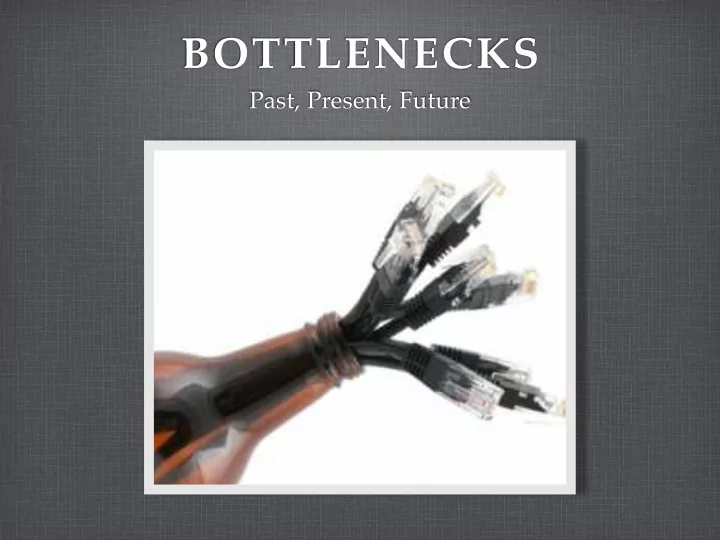

BOTTLENECKS Past, Present, Future
IN THE “BEGINNING” Circa 1980: 10Mb/s local network was a fair alternative to a cheap local disk with 5Mb/s transfer and 50-100ms average seek. Multidrop network installations often had problems.
INEFFICIENCIES File fragmentation and placement limit operational throughput to around 5% of the devices’ maximum 2MB/s. Affordable disk capacities O(1GB) outstripped affordable tape backup (6250 bpi 9-track tape). Poorly performing Ethernet cards were common. Routers could buffer tens of packets. System memory: 20sec. File system: 10min. In theory.
UNIX AND NSFNET BSD Unix brought the “Fast File System” with fewer seeks per file (or directory). TCP over NSFnet WAN (56kb – 45Mb/s) was so fragile, files were generally broken into 50–100kB chunks for transfer.
MID-80’S Distributed processing becomes feasible on the LAN: uux, Berknet, rsh, SUNRPC, Condor. Small datasets move over the wide area in real time...on dedicated links. Large data sets move over lunch, or overnight.
CURRENT PLATFORMS Servers’ 1–10Gb/s 1250MB/s network speeds are well matched to disk or disk SERVER array speeds. High CPU power 750MB/s stealing memory for compute jobs. 150MB/s System memory: 1min. File system: 90min. In theory. DISKS
THE LHC ERA HEP groups brought file catalogs, subscriptions, transfer managers: fewer user commands per file. The entire production and analysis chain is so heterogenous (and in some places, fragile), data sets are broken up into 1–5GB files for transfer and processing.
CURRENT BOTTLENECKS O(10ms) seek ~ 1.5MB File servers: of time. Not much ... Concurrent analysis access is ok: client jobs 150MB/s act compute bound from server’s point of view. Concurrent whole-file (typically WAN) ... unless interleaved transfer slows all with transfers ≲ 15MB. peers.
MITIGATING SEEKS FOR SOME READERS Silicon overlay Fast readers file system Writers, Full copy on Slow readers open for read Disk-based file system
SECURITY BOTTLENECKS GSI requires each endpoint to check several RSA signatures, an O(N 2 ) operation each (for N bit keys). Each endpoint must also generate one signature, an O(N 3 ) operation. To receive a delegation*, the server must do an O(N 4 ) operation. The work is concentrated on the server. Kerberos does less work, and almost all on the client.
KERNEL BOTTLENECKS Preempted network receiving → delayed TCP processing. Throughput ~ 15% Background load 10, CPU and disk only No load
HARDWARE BOTTLENECKS ! Advanced NIC functions RSS: multiple queues, distributed interrupts. Flow Director: packets of a flow pinned to ! one core. !"#$%&%'()*+,%-+)+"."/#%'01)+22%3",4%-55% Linux sometimes does TCP in interrupt context, sometimes in process: large reordering happens. None of these pins the flow to the Application!
PUSHING THE BOTTLENECKS DOWN Network quality s m e File system inefficiency l b o r p d l O Protocol implementation Network capacity and reliability New problems Fragile middleware Kernel scheduling vs. protocol Multicore, multi-cache, interrupts
Recommend
More recommend